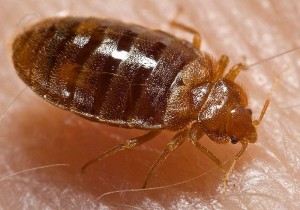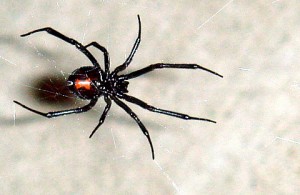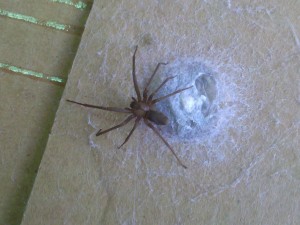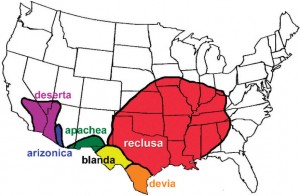Bedbugs have been a rising concern for the last two decades. You can read more about the biology of these pesky house bugs here. In this post we will investigate several methods that might help you deal with them.
The first thing to do is to confirm that you have an infestation, and this can be tricky. Bedbugs can live in large numbers near their food source (you), but they are masters at avoiding detection. Since they generally feed at night, they congregate near beds and sleeping areas. Often they hide in headboards, mattresses, baseboards and carpet crevasses, and bedside furniture. Adults are easily identified when seen as they are about 1/8 of an inch long, dark brown in color, and have dark bands across their backs.
Other telltale signs of bedbugs are blood spots in the bedding, fecal spots in the mattress and box springs, shed skins of the bugs, and of course bites on people. The bites of the bedbugs are on exposed skin, often on the extremities, and the can welt up and itch. You may find that some of the welts line up as the bugs might bite several times while going in a straight line.
Once an infestation has been confirmed action is called for. These pesky bugs can be very hard to eradicate. And for many, they cause great stress and anxiety. When you know that you are being fed upon at night you may hate to crawl into bed and sleep. After all, your bed is your place of refuge, and if you are not safe there, nights can become a nightmare.
The process for getting rid of these little suckers (literally) can be a lot of physical work. Start by physically cleaning all the areas around the bed. Wash all bedding in hot water. The heat will kill any bugs and eggs. Take clutter from around the bed, places where the bugs could hide, and heat treat it as well. You cannot simply tie up the stuff in plastic bags as the bugs and their eggs can live for a very long time between feedings. However, I have found it to be effective to place the bags in your car in the hot sun. Repeated heating in a hot car is enough to kill the bugs and eggs.
Pull drawers out of bedside tables and look behind them, cleaning everything in the drawer and behind the drawer meticulously. A vacuum can help. Clean the crevasses around the baseboards and any cracks. Check the box springs carefully, and clean any debris so at least you can see later if there is new activity.
Bugs can also hide in clothing, so you may need to re-wash your entire wardrobe, and then store it in sealed plastic bags to protect from re-infestation. Clothing should be washed and dried in a hot dryer. You may wish to use the commercial machines at a Laundromat. Vacuum your carpets thoroughly. If you have furniture that is infested you may just wish to throw it away. If you do however, be sure to either destroy it or mark it clearly that it is infested so someone else does not carry it home.
Even all this meticulous cleaning will likely not be enough. There are a number of non-chemical treatments that have been suggested. I offer them there for those who would like to avoid the chemicals, but realistically I am not sure how effective they really are.
There are commercially made bed bug traps. Mattress covers might be a good idea. They are designed to trap any bugs inside so they cannot get to you. You would need to also cover the box springs. And while they may trap those already inside, that is likely not the only population you have. Bed post dishes have been suggested. This is where you place the bed legs into a container and put oil or something similar that the bugs cannot cross. The idea is it keeps the bugs from climbing up into the bed in the first place. The problem with this is you have to keep the containers full, and it would only take one time of a blanket falling to the floor, or of you having a bug on a bed slipper and unknowingly giving it a lift to the bed.
Diatomaceous earth has been suggested. The idea here is that the clay will desiccate the bugs, dry them out, and kill them. But direct contact with the bugs is required, and if they are not adequately covered it will have no effect.
Heat does kill the bugs, so steam can be effective. The problem with it is the heat has to be applied very close to the bug itself, and if you cannot get the steam deep into every surface where the bugs might hide, they simply will retreat to a safe place and reemerge.
As much as we all shy away from chemicals, this may be a time to bring out the big guns. I highly recommend a professional exterminator as they are trained in the use and application of the insecticides, and since you will be spraying surfaces that you will come into contact with it is best to get professional help.
I have read (but an not endorsing) that you can effectively spray for the bugs yourself by using a combination of 2 oz of Cy-Kicks-CS (with 6% cyfluthrin) and 1 oz of Martins IGR (1.3% of 2-{1methyl2(4phenoxyphenoxy)ethoxy}pyridine) per gallon of water. These chemicals should be available at a local do-it-yourself store. You will have to repeat the spraying and thorough cleaning of all areas 5 to 7 days after the first treatment as the bugs are not killed instantly but the chemicals inhibits growth and breeding.
Bedbug infestations can be a nightmare. It is best to catch them early. Also, be aware that if you live in a multi-unit dwelling, you cannot just treat one apartment—all of them must be thoroughly dealt with or the bugs will simply move from unit to unit.
So, sleep tight, and don’t let the bedbugs bite—ever again!



